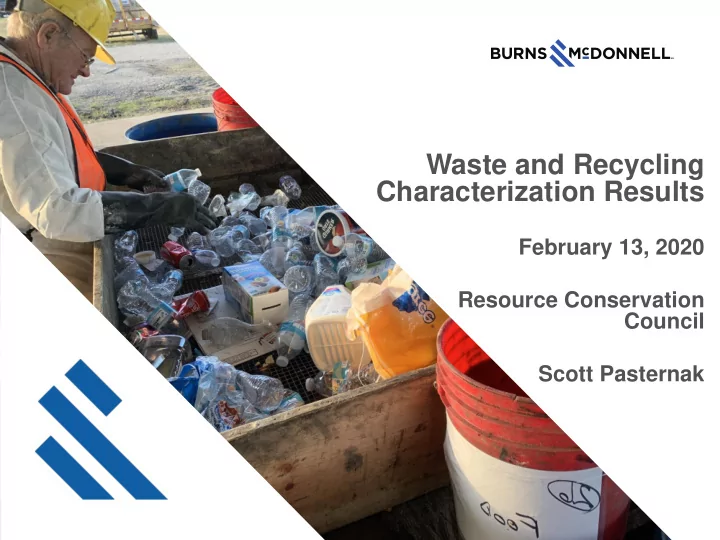

Waste and Recycling Characterization Results February 13, 2020 Resource Conservation Council Scott Pasternak
Waste Characterization Study Methodologies 2018 2019 Participating Cities 10 8 Trash Samples 50 49 None; used MRF Recycling Samples 44 audit data Material Categories 31 34 ► Study methodology changes between 2018 and 2019 • Two cities unable to participate in 2019 • Included hand-sorting of recycling in 2019 • Added e-commerce OCC, pizza boxes, and polypropylene (#5 plastic) categories to provide additional perspective 2
Participating Cities Involvement ► Collected samples and tracked pickups Cities Dallas ► Transported and delivered samples Fort Worth ► Represented a range of solid waste collection Arlington programs varying by Garland • Size of program Grand Prairie • Set out type (e.g. cart, bags) Irving* Frisco • Collection frequency (e.g. weekly, every Mesquite other week) Allen* Weatherford *unavailable to participate in 2019 sorting event 3
Waste Delivery 4
Hand-Sorting Material 5
Fines Screens 6
Weight Data Collection 7
Sorting Bins From Participating Cities 8
Waste and Recycling Characterization Data Analysis ► Regional analysis replicated 2018 study plus hand- sorted recycling to provide • Waste and recycling composition • Contamination rate • Capture rate • Value of material disposed ► Hand-sorting recycling allowed additional analysis on participating cities including • Individual waste and recycling composition • Participating cities’ capture rate 9
Data Analysis Limitations Effectiveness of Year over Year Extrapolating Regional Comparison Data Campaign • 2018 recycling • Individual city • Behavior change data based on composition / requires MRF audits capture rate sustained • 2019 recycling cannot be campaign extrapolated due • Individual cities data based on to small sample hand-sort adopting size • Cannot directly campaign critical • Hand-sorted • Behavior change compare region- recycling wide and occurs at the contamination participating cities source of higher than MRF capture rates recycling audits 1 0
2019 Regional Garbage Composition Problem Materials Other 2% C&D 4% 1% Paper 19% Plastic 16% Organics 50% Metal Glass 3% 5% Note: see handout for detailed waste composition profile 1 1
2019 Regional Recycling Composition Problem Materials C&D Regional contamination rate Other 1% 1% estimated at 24%. Included 1% material categories Organics 10% • Non-recyclable OCC • Other non-recyclable paper • Non-recyclable plastic* Paper Glass • Non-recyclable glass 16% 50% • Organics* • C&D • Problem material Metal • Fines and other organics 4% Plastic 17% *higher percentage than typical MRF audit due to material category differences and handling Note: see handout for detailed waste composition profile 1 2
Overall Capture Rates Capture Rate Capture Recycling Garbage Methodology Rate Participating 3,526 lbs. 1,604 lbs. 69% Cities Regional 411,223 tons 967,176 tons 30% ► Weight of recyclables in recycling and garbage streams used to calculate overall capture rate • Participating cities capture rate sums material segregated during sorting event • Regional capture rate extrapolates garbage and recycling composition profiles across all material disposed/processed in North Central Texas ► Following slides present capture rate by material category for each methodology 1 3
2019 Participating Cities Capture Rate 2019 Participating Cities Recyclable Material Capture Rate Recyclable OCC 86% Mixed Paper 65% PET Containers 56% HDPE Containers - Natural 65% HDPE Containers - Colored 61% #3-#7 Containers 35% Aluminum Used Beverage 63% Containers Ferrous Metal Food Containers 44% Recyclable Glass 68% Note: figures calculated by compiling total weight of material segregated at the sorting event – does not represent region-wide capture rate 1 4
Regional Capture Rate Comparison 2018 2019 Year-over- Recyclable Material Regional Regional Year Capture Rate Capture Rate Change Recyclable OCC 60% 59% -1% Mixed Paper 41% 34% -7% PET Containers 22% 25% 3% HDPE Containers - Natural 28% 28% 0% HDPE Containers - Colored 30% 26% -4% #3-#7 Containers 14% 11% -3% Aluminum Used Beverage 19% 26% 7% Containers Ferrous Metal Food 18% 14% -4% Containers Recyclable Glass 25% 34% 10% Note: figures calculated by extrapolating composition for garbage and recycling over total disposed and processed in region. Different analysis than sample-based capture rate 1 5
Conclusions ► Regional composition indicates • High levels of e-commerce packaging and clean pizza boxes in refuse stream • #5 polypropylene (clamshell containers) significant portion of #3-#7 plastic • High volume of organics present in refuse (50%) and recycling (10.5%) ► Regional capture rate comparison shows • Improved capture of PET and aluminum between 2019 and 2019 • Increase focus on capture of HDPE and steel cans • Hand-sorting recyclables provides more granular capture rate analysis ► Continued regional campaign and integration of content into individual city outreach will provide • Improved capture rates of key materials over time • Decreased contamination rates entering MRFs 1 6
Questions? Scott Pasternak Burns & McDonnell 512-872-7141 spasternak@burnsmcd.com Eric Weiss Burns & McDonnell 512-975-7873 ebweiss@burnsmcd.com 1 7
Recommend
More recommend